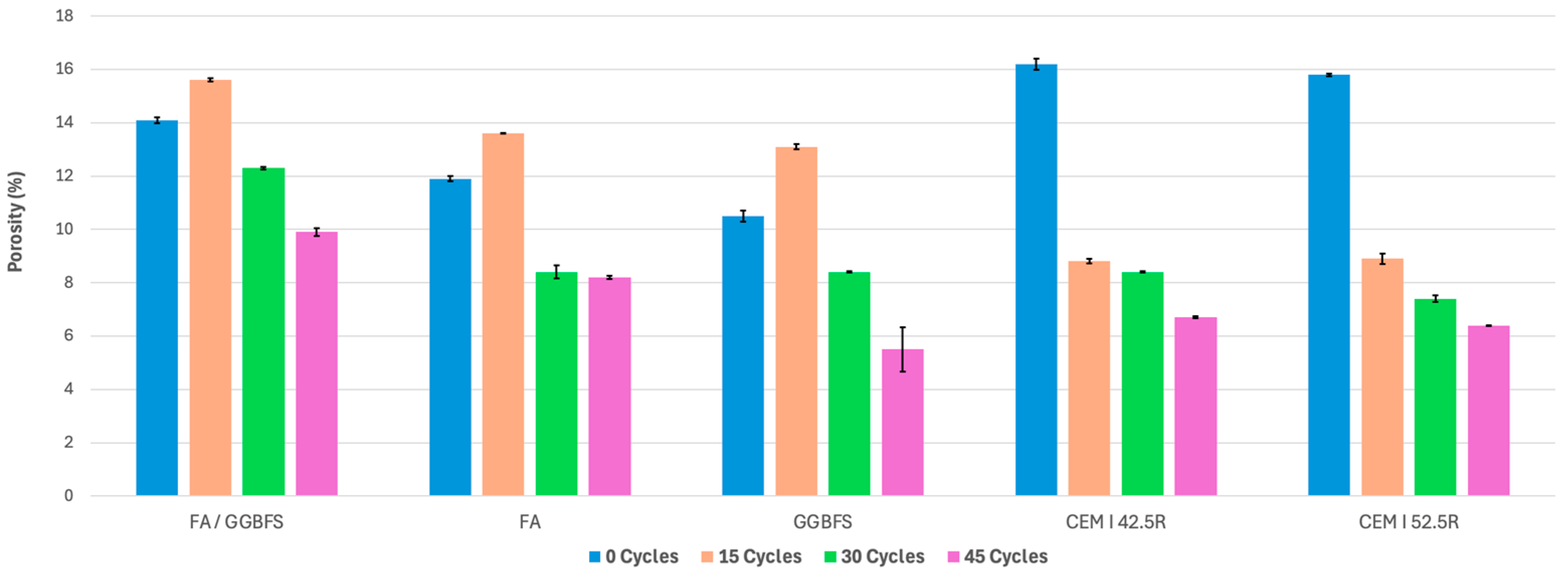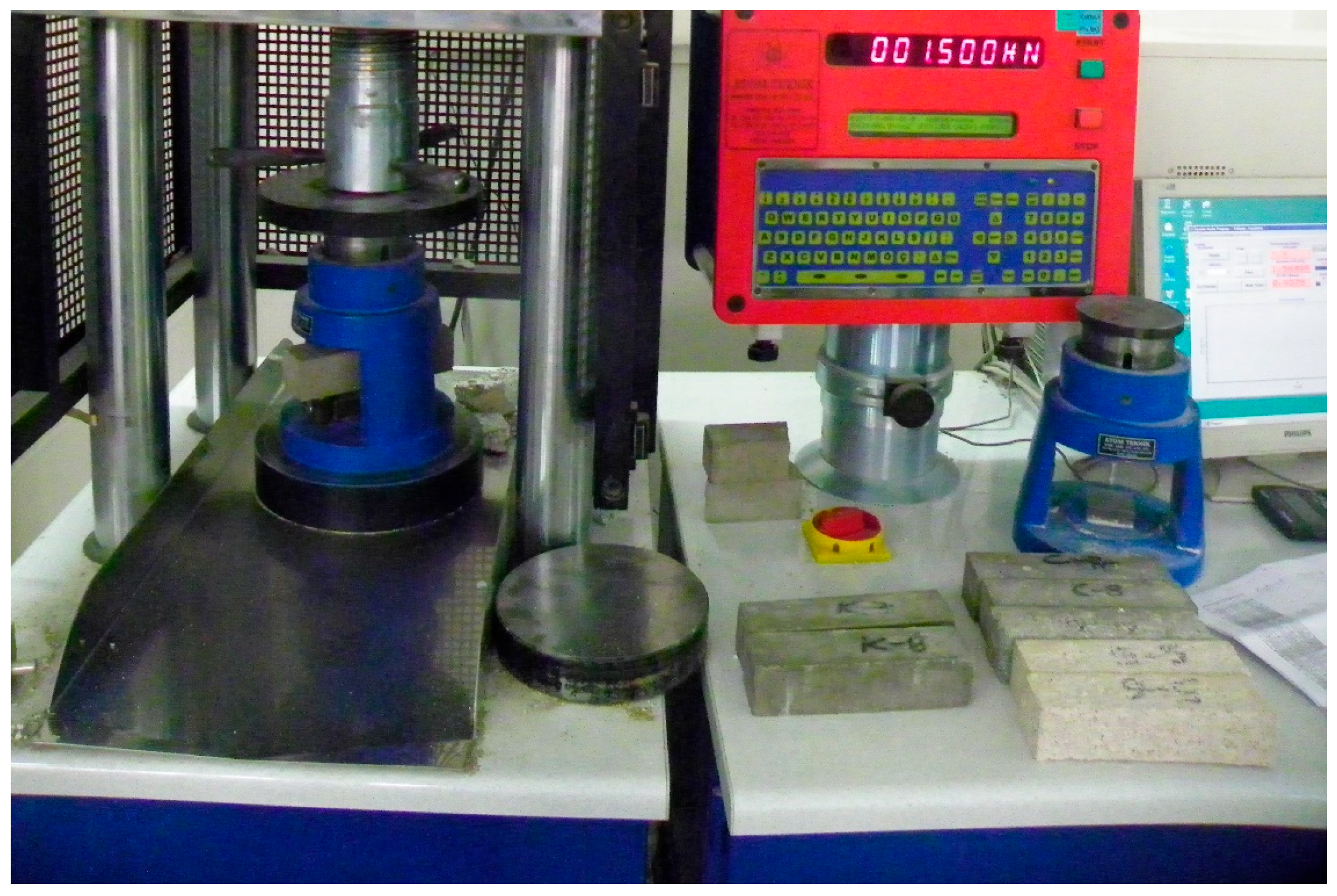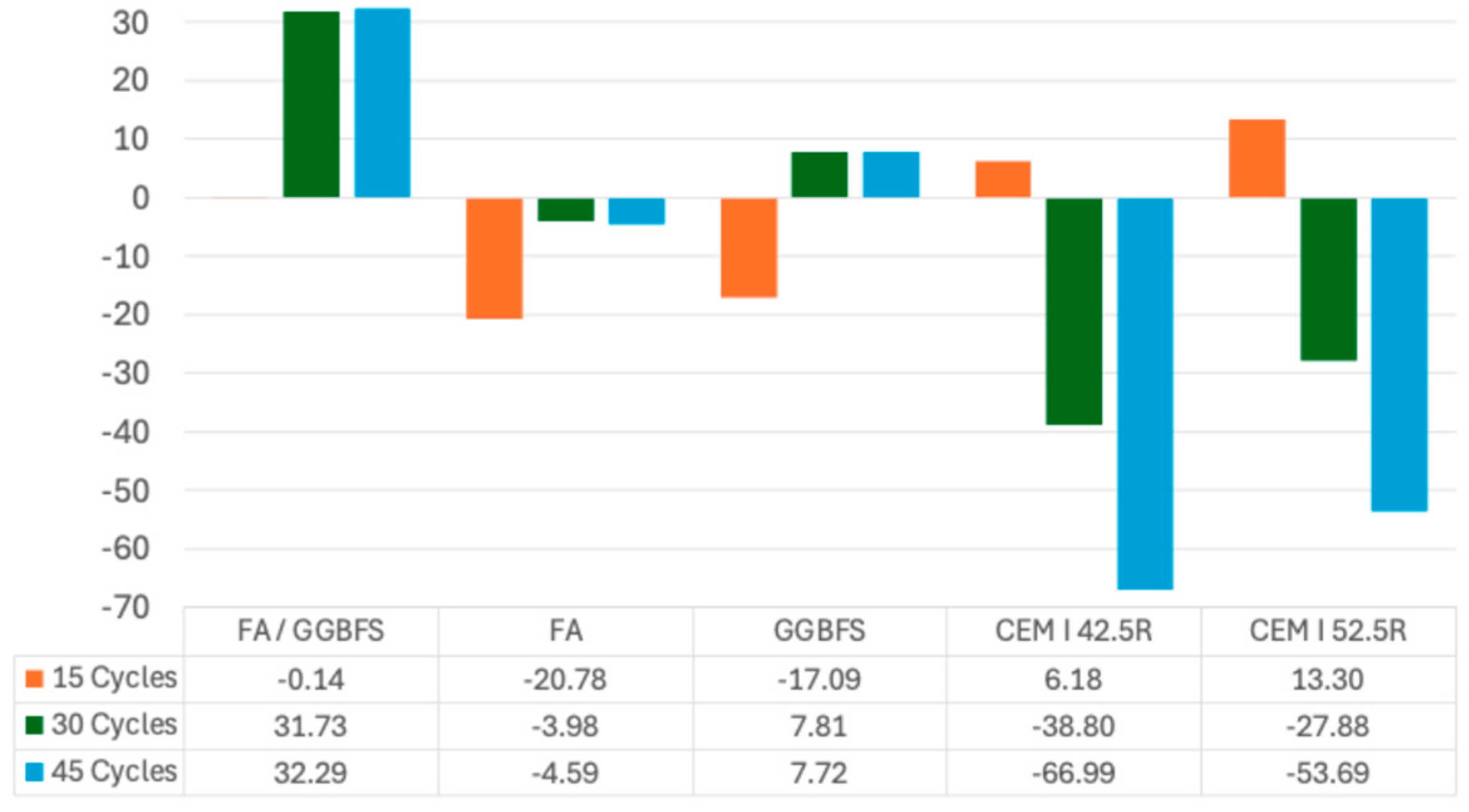Alkali-Activated Binders as Sustainable Alternatives to Portland Cement and Their Resistance to Saline Water
Abstract
1. Introduction
2. Experimental Program
2.1. Materials
2.2. Preparation of Mortar Samples and Test Methods
3. Results and Discussion
- Chemical interactions and material composition: Chemical reactions in alkali-activated mortars (FA/GGBFS, FA, and GGBFS) lead to the formation of dense polymeric structures, which enhance the flexural strength. The material composition plays a crucial role, as the combination of FA and GGBFS creates a stronger, durable matrix.
- Microstructural changes: Exposure to wet–dry cycles can induce microstructural changes in the mortars. Alkali-activated mortars benefit from these changes, improving their flexural strength over time.
- Moisture absorption and porosity: The ability of mortars to absorb moisture and their porosity influence flexural strength. Alkali-activated mortars, which exhibit lower water absorption and porosity with increased cycles, maintain or improve their flexural strength over time.
- Environmental stressors and degradation: Traditional OPC mortars (CEM I 42.5R and CEM I 52.5R) experience more significant challenges from environmental stressors such as moisture and saline exposure. This can lead to microcracks and deterioration, resulting in a decline in the flexural strength over time. For instance, FA mortars declined significantly in their flexural strength from 6.0 MPa at 15 cycles to 3.8 MPa after 45 cycles.
- Leaching and degradation: Traditional cement mortars (CEM I 42.5R and CEM I 52.5R) experienced significant declines in their compressive strength over time, such as a decrease from 51.8 MPa at 0 cycles to 17.1 MPa after 45 cycles for CEM I 42.5R. This decline can be attributed to chemical deterioration and leaching of calcium salts.
- Capillary action and moisture uptake: Exposure to wet–dry cycles can cause moisture uptake and loss, potentially leading to microcracks and internal stresses within the mortars. This is more detrimental to traditional cement mortars, which show decreased compressive strength over time.
- Material composition and bonding: The composition and bonding of mortar materials influence their response to cycles. Alkali-activated mortars, particularly those composed of FA/GGBFS and GGBFS, exhibit resilience and improved compressive strength due to their dense structure and strong bonding.
4. Conclusions
Author Contributions
Funding
Institutional Review Board Statement
Informed Consent Statement
Data Availability Statement
Conflicts of Interest
References
- Luga, E.; Atis, C.D. Strength Properties of Slag/Fly Ash Blends Activated with Sodium Metasilicate and Sodium Hydroxide + Silica Fume. Period. Polytech. Civ. Eng. 2016, 60, 223–228. [Google Scholar] [CrossRef]
- Ouellet-Plamondon, C.; Habert, G. Life cycle analysis (LCA) of alkali-activated cements and concretes. In Handbook of Alkali-Activated Cements, Mortars and Concretes; WoodHead Publishing; Elsevier: Cambridge, UK, 2014; pp. 663–686. [Google Scholar]
- Provis, J.L.; Palomo, A.; Shi, C. Advances in understanding alkali-activated materials. Cem. Concr. Res. 2015, 78, 110–125. [Google Scholar] [CrossRef]
- Nodehi, M.; Ozbakkaloglu, T.; Gholampour, A.; Mohammed, T.; Shi, X. The effect of curing regimes on physico-mechanical microstructural and durability properties of alkali-activated materials: A review. Constr. Build. Mater. 2022, 321, 126335. [Google Scholar] [CrossRef]
- El-Hassan, H.; Elkholy, S. Performance evaluation and microstructure characterization of steel fiber-reinforced alkali-activated slag concrete incorporating fly ash. J. Mater. Civ. Eng. 2019, 31, 04019223. [Google Scholar] [CrossRef]
- Rafeet, A.; Vinai, R.; Soutsos, M.; Sha, W. Effects of slag substitution on physical and mechanical properties of fly ash-based Alkali-Activated Binders (AABs). Cem. Concr. Res. 2019, 122, 118–135. [Google Scholar] [CrossRef]
- Atis, C.; Görür, E.; Karahan, O.; Bilim, C.; Ilkentapar, S.; Luga, E. Very high strength (120 MPa) class F fly ash geopolymer mortar activated at different NaOH amount heat curing temperature and heat curing duration. Constr. Build. Mater. 2015, 96, 673–678. [Google Scholar] [CrossRef]
- Luga, E.; Atis, C.D.; Karahan, O.; Ilkentapar, S.; Gorur, E.B. Strength properties of slag/fly ash blends activated with sodium metasilicate. Gradevinar 2017, 69, 199–205. [Google Scholar] [CrossRef]
- Luga, E.; Atis, C.D. Optimization of heat cured fly ash/slag blend geopolymer mortars designed by “Combined Design” method: Part 1. Constr. Build. Mater. 2018, 178, 393–404. [Google Scholar] [CrossRef]
- ACI 201.2R-92; Guide to Durable Concrete. Manual of Concrete Practice. American Concrete Institute: Detroit, MI, USA, 1992.
- Kovalchuk, G.; Fernandez-Jimenez, A.; Palomo, A. Alkali-activated fly ash: Effect of thermal curing conditions on mechanical and microstructural development-Part II. Fuel 2007, 86, 315–322. [Google Scholar] [CrossRef]
- Wongpa, J.; Kiattikomol, K.; Jaturapitakkul, C.; Chindaprasirt, P. Compressive strength, modulus of elasticity, and water permeability of inorganic polymer concrete. Mater. Des. 2010, 31, 4748–4754. [Google Scholar] [CrossRef]
- van Deventer, J.; Provis, J.; Duxson, P.; Lukey, G.C. Reaction mechanisms in the geopolymeric conversion of inorganic waste to useful products. J. Hazard. Mater. 2007, 139, 506–513. [Google Scholar] [CrossRef] [PubMed]
- Aiken, T.; Kwasny, J.; Sha, W.; Tong, K. Mechanical and durability properties of alkali-activated fly ash concrete with increasing slag content. Constr. Build. Mater. 2021, 301, 124330. [Google Scholar] [CrossRef]
- Davidovits, J.; Davidovics, M. Geopolymer room temperature ceramic matrix for composites. Ceram. Eng. Sci. Proc. 1988, 9, 835–842. [Google Scholar]
- Palomo, A.; Macias, A.; Blanco, M.; Puertas, F. Physical, Chemical, and Mechanical Characterization of Geopolymers. In Proceedings of the 9th International Congress on the Chemistry of Cement, New Delhi, India, 23–28 November 1992. [Google Scholar]
- Kamseu, E.; Leonelli, C. Synthesis of Polysialate Matrices from Al-Rich and Si-Rich Metakaolins: Polycondensation and Physico-chemical Properties. In Proceedings of the 34th International Conference and Exposition on Advanced Ceramics and Composites (ICACC), Daytona Beach, FL, USA, 24–29 January 2010. [Google Scholar]
- Li, Q.; Li, X.; Yang, K.; Zhu, X.; Gevaudan, J.P.; Yang, C.; Basheer, M. The long-term failure mechanisms of alkali-activated slag mortar exposed to wet-dry cycles of sodium sulphate. Cem. Concr. Compos. 2021, 116, 103893. [Google Scholar] [CrossRef]
- Monticelli, C.; Natali, M.E.; Balbo, A.; Chiavari, C.; Zanotto, F.; Manzi, S.; Bignozzi, M.C. A study on the corrosion of reinforcing bars in alkali-activated fly ash mortars under wet and dry exposures to chloride solutions. Cem. Concr. Res. 2016, 87, 53–63. [Google Scholar] [CrossRef]
- Saravanakumar, P.; Kalaivani, P. Behaviour of alkali-activated concrete under marine conditions. IOP Conf. Ser. Mater. Sci. Eng. 2020, 872, 012167. [Google Scholar] [CrossRef]
- Sun, X.; Hua, Y.; Mao, S.; Zhang, Y. Experimental research on the influence of dry-wet cycle on concrete compressive strength. IOP Conf. Ser. Earth Environ. Sci. 2021, 714, 032016. [Google Scholar] [CrossRef]
- Zhang, J.; Gao, Y.; Han, Y. Interior humidity of concrete under dry-wet cycles. J. Mater. Civ. Eng. 2011, 24, 289–298. [Google Scholar] [CrossRef]
- Yang, Z.; Zhan, X.; Zhu, H.; Zhang, B.; Feng, P.; Li, H.; Kua, H.W. Performance-based alkali-activated seawater sea-sand concrete: Mixture optimization for mechanical, environmental, and economical objectives. Constr. Build. Mater. 2023, 409, 134156. [Google Scholar] [CrossRef]
- Dehestani, A.; Hosseini, M.; Taleb Beydokhti, A. Effect of wetting–drying cycles on mode I and mode II fracture toughness of cement mortar and concrete. Theor. Appl. Fract. Mech. 2020, 106, 102448. [Google Scholar] [CrossRef]
- Noor-E-Khuda, S. Influence of wetting–drying cycles on compressive and flexural strength of cement mortar and CFRP-mortar bond strength. Constr. Build. Mater. 2021, 271, 121513. [Google Scholar] [CrossRef]
- ASTM C989; Standard Specification for Slag Cement for Use in Concrete and Mortars. American Society for Testing and Materials: Philadelphia, PA, USA, 2014.
- EN 450-1; Fly Ash for Concrete—Part 1: Definitions, Specifications, and Conformity Criteria. European Committee for Standardization (CEN): Brussels, Belgium, 2012.
- ASTM C618-94a; Standard Specification for Coal and Fly Ash and Raw or Calcined Natural Pozzolan for Use As a Mineral Admixture in Portland Cement Concrete. Annual Book of ASTM Standards, V. 04.02, Concrete and Aggregates. American Society for Testing and Materials: Philadelphia, PA, USA, 1997.
- EN 197-1; Cement—Part 1: Composition, Specifications and Conformity Criteria for Common Cements. European Committee for Standardization (CEN): Brussels, Belgium, 2011.
- EN 196-1; Methods of Testing Cement—Part 1: Determination of Strength. European Committee for Standardization (CEN): Brussels, Belgium, 2009.
- EN 1015–11; Mortar Testing Method—Part 11: Determination of Flexural and Compressive Strength of Hardened Mortar. European Committee for Standardization (CEN): Brussels, Belgium, 2000.








| Oxide | SiO2 | Al2O3 | Fe2O3 | CaO | MgO | SO3 | K2O | Na2O | LOI |
|---|---|---|---|---|---|---|---|---|---|
| GGBFS | 36.7 | 5.20 | 0.98 | 32.61 | 10.12 | 0.99 | 0.76 | 0.42 | 2.88 |
| FA | 61.81 | 19.54 | 7.01 | 1.77 | 2.56 | 0.31 | 0.99 | 2.43 | 2.20 |
| CEM I 42.5R | 18.87 | 5.62 | 2.54 | 62.78 | 2.63 | 2.82 | 0.9 | 0.4 | - |
| CEM I 52.5R | 21.6 | 4.05 | 0.26 | 65.7 | 1.30 | 3.30 | - | - | - |
| Series | FA (g) | GGBFS (g) | OPC (g) | Water (g) | NaOH (g) | Sand (g) | Curing Temperature (°C) | Curing Period (Days) |
|---|---|---|---|---|---|---|---|---|
| FA/GGBFS | 255 | 195 | - | 180 | 121 | 1350 | 100 | 3 |
| FA | 450 | - | - | 180 | 142 | 1350 | 100 | 3 |
| GGBFS | - | 450 | - | 180 | 150 | 1350 | 100 | 3 |
| CEM I 42.5R | - | - | 450 | 225 | - | 1350 | 21 ± 1 | 28 |
| CEM I 52.5R | - | - | 450 | 225 | - | 1350 | 21 ± 1 | 28 |
| Number of Wet–Dry Cycles | Water Absorption (%) | COV | Porosity (%) | COV | Flexural Strength (MPa) | COV | Compressive Strength (MPa) | COV | |
|---|---|---|---|---|---|---|---|---|---|
| 0 | 6.8 | 0.019 | 14.1 | 0.022 | 7.4 | 0.05 | 66.5 | 0.02 | |
| FA/GGBFS | 15 | 7.6 | 0.026 | 15.6 | 0.019 | 8.3 | 0.09 | 66.4 | 0.05 |
| 30 | 5.8 | 0.047 | 12.3 | 0.041 | 5.5 | 0.01 | 87.6 | 0.02 | |
| 45 | 4.7 | 0.048 | 9.9 | 0.041 | 7.2 | 0.19 | 87.9 | 0.06 | |
| 0 | 5.7 | 0.013 | 11.9 | 0.009 | 11.0 | 0.15 | 74.1 | 0.04 | |
| FA | 15 | 6.6 | 0.015 | 13.6 | 0.013 | 6.0 | 0.14 | 58.7 | 0.03 |
| 30 | 4.0 | 0.008 | 8.4 | 0.004 | 4.0 | 0.04 | 71.1 | 0.09 | |
| 45 | 3.8 | 0.016 | 8.2 | 0.020 | 3.8 | 0.23 | 70.7 | 0.36 | |
| 0 | 4.9 | 0.028 | 10.5 | 0.017 | 6.4 | 0.05 | 75.5 | 0.07 | |
| GGBFS | 15 | 6.2 | 0.014 | 13.1 | 0.038 | 4.1 | 0.17 | 62.6 | 0.33 |
| 30 | 3.9 | 0.008 | 8.4 | 0.011 | 5.5 | 0.11 | 81.4 | 0.04 | |
| 45 | 2.6 | 0.047 | 5.5 | 0.049 | 5.9 | 0.17 | 81.3 | 0.05 | |
| 0 | 7.9 | 0.018 | 16.2 | 0.005 | 8.6 | 0.08 | 51.8 | 0.05 | |
| CEM I | 15 | 3.6 | 0.008 | 8.8 | 0.005 | 6.2 | 0.01 | 55.0 | 0.02 |
| 42.5R | 30 | 3.9 | 0.039 | 8.4 | 0.025 | 7.4 | 0.04 | 31.7 | 0.04 |
| 45 | 3.1 | 0.029 | 6.7 | 0.027 | 7.4 | 0.01 | 17.1 | 0.16 | |
| 0 | 7.6 | 0.023 | 15.8 | 0.013 | 10.1 | 0.13 | 62.4 | 0.02 | |
| CEM I | 15 | 4.1 | 0.170 | 8.9 | 0.168 | 11.5 | 0.06 | 70.7 | 0.04 |
| 52.5R | 30 | 3.4 | 0.029 | 7.4 | 0.007 | 7.3 | 0.03 | 45.0 | 0.04 |
| 45 | 2.9 | 0.003 | 6.4 | 0.002 | 7.0 | 0.08 | 28.9 | 0.08 |
Disclaimer/Publisher’s Note: The statements, opinions and data contained in all publications are solely those of the individual author(s) and contributor(s) and not of MDPI and/or the editor(s). MDPI and/or the editor(s) disclaim responsibility for any injury to people or property resulting from any ideas, methods, instructions or products referred to in the content. |
© 2024 by the authors. Licensee MDPI, Basel, Switzerland. This article is an open access article distributed under the terms and conditions of the Creative Commons Attribution (CC BY) license (https://creativecommons.org/licenses/by/4.0/).
Share and Cite
Luga, E.; Mustafaraj, E.; Corradi, M.; Atiș, C.D. Alkali-Activated Binders as Sustainable Alternatives to Portland Cement and Their Resistance to Saline Water. Materials 2024, 17, 4408. https://doi.org/10.3390/ma17174408
Luga E, Mustafaraj E, Corradi M, Atiș CD. Alkali-Activated Binders as Sustainable Alternatives to Portland Cement and Their Resistance to Saline Water. Materials. 2024; 17(17):4408. https://doi.org/10.3390/ma17174408
Chicago/Turabian StyleLuga, Erion, Enea Mustafaraj, Marco Corradi, and Cengiz Duran Atiș. 2024. "Alkali-Activated Binders as Sustainable Alternatives to Portland Cement and Their Resistance to Saline Water" Materials 17, no. 17: 4408. https://doi.org/10.3390/ma17174408
APA StyleLuga, E., Mustafaraj, E., Corradi, M., & Atiș, C. D. (2024). Alkali-Activated Binders as Sustainable Alternatives to Portland Cement and Their Resistance to Saline Water. Materials, 17(17), 4408. https://doi.org/10.3390/ma17174408









